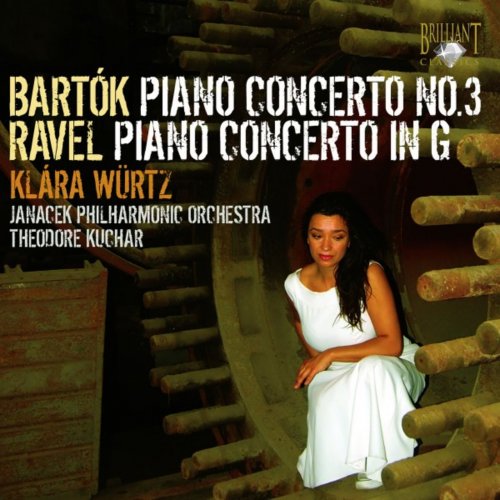
Klára Würtz, Janáček Philharmonic Orchestra, Theodore Kuchar - Bartok, Ravel: Piano Concertos (2009)
BAND/ARTIST: Klára Würtz, Janáček Philharmonic Orchestra, Theodore Kuchar
- Title: Bartok, Ravel: Piano Concertos
- Year Of Release: 2009
- Label: Brilliant Classics
- Genre: Classical
- Quality: FLAC (tracks)
- Total Time: 45:34
- Total Size: 190 Mb
- WebSite: Album Preview
Tracklist:
Bela Bartok: Piano concerto no. 3
1. Piano Concerto No. 3, Sz. 119: I. Allegretto
2. Piano Concerto No. 3, Sz. 119: II. Adagio religioso
3. Piano Concerto No. 3, Sz. 119: III. Allegro vivace
Maurice Ravel: Piano concerto in G
4. Piano Concerto in G Major: I. Allegramente
5. Piano Concerto in G Major: II. Adagio assai
6. Piano Concerto in G Major: III. Presto
Performers:
Klára Würtz, piano
Janáček Philharmonic Orchestra
Theodore Kuchar, conductor
Bela Bartok: Piano concerto no. 3
1. Piano Concerto No. 3, Sz. 119: I. Allegretto
2. Piano Concerto No. 3, Sz. 119: II. Adagio religioso
3. Piano Concerto No. 3, Sz. 119: III. Allegro vivace
Maurice Ravel: Piano concerto in G
4. Piano Concerto in G Major: I. Allegramente
5. Piano Concerto in G Major: II. Adagio assai
6. Piano Concerto in G Major: III. Presto
Performers:
Klára Würtz, piano
Janáček Philharmonic Orchestra
Theodore Kuchar, conductor
Klára Würtz studied with Zoltan Kocsis and Gyorgy Kurtag, and received a scholarship from András Schiff for his masterclasses at Prussia Cove, Cornwall, UK. She has since performed widely in the North America and Europe When Bartók started work on his Third and last piano concerto in 1944, he was already ill, and in exile in the United States. The following year he died, leaving the concerto almost complete. His pupil Tibor Serly completed the final bars using Bartók’s instructions. The concerto was premiered in 1946 and was an immediate success. Unlike much of his earlier work, the Third concerto like the Concerto for Orchestra shows a more approachable and less modernistic character. The public had balked at Bartók’s spiky and percussive music, and the comparatively warm, almost wistful romanticism of the Third concerto provides an ideal introduction to the composer. The work is the summation of his close relationship with the concertos of the classical and romantic period composers he admired – Mozart, Beethoven, Liszt and Richard Strauss. Ravel was determined to write just one work in each genre, and if he ever deviated from his rule, the resulting work in the same genre contrasted greatly with its companion. His two piano concertos were composed around 1930. The Concerto for the Left Hand is a very challenging work for the performer, and the mood is predominantly dark and brooding. In contrast the Concerto in G was described by Ravel as a divertissement, and he said that Mozart and Saint-Saëns provided the inspiration. Allied to these influences is Ravel’s love of jazz which can be detected in the first movement and the finale which frame a serene and beautiful slow movement.
As a ISRA.CLOUD's PREMIUM member you will have the following benefits:
- Unlimited high speed downloads
- Download directly without waiting time
- Unlimited parallel downloads
- Support for download accelerators
- No advertising
- Resume broken downloads


